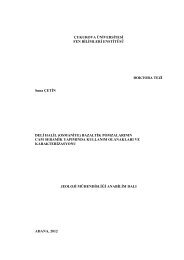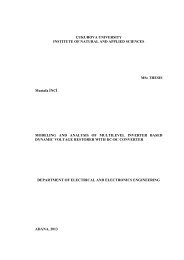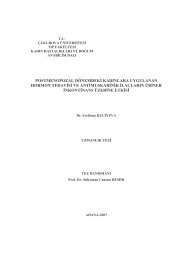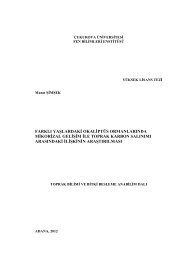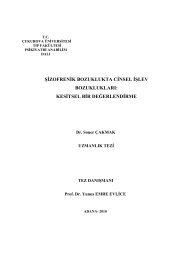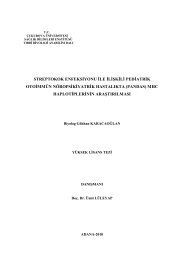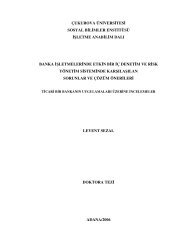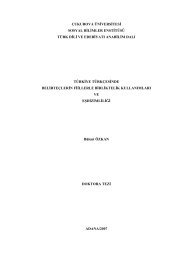Mentagrophytes - Çukurova Üniversitesi
Mentagrophytes - Çukurova Üniversitesi
Mentagrophytes - Çukurova Üniversitesi
You also want an ePaper? Increase the reach of your titles
YUMPU automatically turns print PDFs into web optimized ePapers that Google loves.
36. Hilmioğlu S. Dermatomikozlarda laboratuvar tanı. In: Özbal Y, Koç N, Eds. 2. Ulusal Mantar<br />
Hastalıkları ve Klinik Mikoloji Simpozyumu: Dermatomikoz etkenleri ve dermatomikozlar (3-4<br />
Haziran 2004, Kayseri)- Tutanaklar. Türk Mikrobiyoloji Cemiyeti Yayını No:48, 2004: 55-61.<br />
37. Clayton YM, Midgley G. Identification of agents of superficial mycoses. In: Evans EGV,<br />
Richardson MD, Eds. Medical Mycology: A Practical Approach. IRL Press: Oxford, 1989: 65-97.<br />
38. Asawanonda P, Taylor CR. Wood’s light in dermatology. Int J Dermatol, 1999; 38:801-807.<br />
39. Philpot C. The use of nutritional tests for the differentiation of dermatophytes. Sabouraudia, 1977;<br />
15:141-150.<br />
40. Carmichael JW, Sekhon AS, Sigler L. Classification of some dermatophytes by pyrolysis-gasliquid<br />
chromatography. Can J Microbiol, 1973; 19:403-7.<br />
41. Brasch J, Zaldua M. Enzyme patterns of dermatophytes. Mycoses, 1994; 37:11-16.<br />
42. Bock M, Maiwald M, Kappe R, Nickel P, Naher H. Polymerase chain reaction-based detection<br />
of dermatophyte DNA with a fungus-specific primer system. Mycoses, 1994; 37:79-84.<br />
43. Gräser Y, el Fari M, Presber W, Sterry W, Tietz HJ. Identification of common deratophytes<br />
(Trichophyton, Microsporum, Epidermophyton) using polymerase chain reactions. Br J Dermatol,<br />
1998; 138:576-582.<br />
44. Makimura K, Tamura Y, Mochizuki T, et al. Phylogenetic classification and species<br />
identification of dermatophyte strains based on DNA sequences of nuclear ribosomal internal<br />
transcribed spacer 1 regions. J Clin Microbiol, 1999; 37:920-924.<br />
45. Harmsen D, Schwinn A, Bröcker EB, Frosch M. Molecular differentiation of dermatophyte<br />
fungi. Mycoses, 1999; 42:67-70.<br />
46. El Fari M, Tietz HJ, Presber W, Sterry W, Gräser Y. Development of an oligonucleotide probe<br />
specific for Trichophyton rubrum. Br J Dermatol, 1999; 141:240-245.<br />
47. Machouart-Dubach M, Lacroix C, de Chauvin MF, et al. Rapid discrimination among<br />
dermatophytes, Scytalidium spp., and other fungi with a PCR-restriction fragment lenght<br />
polymorphism ribotyping method. J Clin Microbol, 2001;39: 685-690.<br />
48. Shin JH, Sung JH, Park SJ, et al. Species identification and strain differentiation of<br />
dermatophyte fungi using polymerase chain reaction amplification and restriction enzyme analysis.<br />
J Am Acad Dermatol, 2003; 48:857-865.<br />
49. Gräser Y, Kuijpers AF, Presber W, de Hoog GS. Molecular taxonomy of the Trichophyton<br />
rubrum complex. J Clin Microbiol, 2000; 38:3329-3336.<br />
50. Ohst T, de Hoog GS, Presber W, Stavrakieva V, Gräser Y. Origins of microsatellite diversity in<br />
the Trichophyton rubrum-T.violaceum clade (Dermatophytes). J Clin Microbiol, 2004; 42:4444-<br />
4448.<br />
51. Kane J. Trichophyton fischeri sp. nov.: a saprophyte resembling Trichophyton rubrum.<br />
Sabouraudia, 1977; 15:231-241.<br />
52. Rosenthal SA, Scott JS, Summerbell RC, Kane J. First isolation of Trichophyton fischeri in the<br />
United States. J Clin Microbiol, 1998; 36:3389-3391.<br />
53. Summerbell RC. Trichophyton kanei sp. nov., a new anthropophilic dermatophyte. Mycotaxon,<br />
1987; 28:509-523.<br />
78



